Power to Puerto Rico: Resilient, Renewable Microgrids
Air Date: Week of October 6, 2017

The Universidad de Puerto Rico showcased its solar-powered house for the U.S. Department of Energy Solar Decathlon on the National Mall in Washington, D.C., October 2009. Puerto Rico’s renewable energy contributed a little over 2 percent of the overall energy mix prior to Hurricane Maria. (Photo: Stefano Paltera/US Dept. of Energy Solar Decathlon, Flickr CC BY-ND 2.0)
Before Hurricane Maria devastated the island, Puerto Rico relied on an outdated, centralized power grid that burned imported fossil fuels. It will likely take be months or more to restore the system, but Robert Engelman of the environmental think tank Worldwatch Institute says this disaster offers the chance to rebuild Puerto Rico’s power system with more resilience and less carbon. Engelman and host Steve Curwood discuss how renewable energy and distributed microgrids can save costs and be a better solution to extreme weather.
Transcript
CURWOOD: From PRI, and the Jennifer and Ted Stanley Studios at the University of Massachusetts Boston, this is Living on Earth. I’m Steve Curwood.
Puerto Rico was once covered by electric shades of green, lush tropical trees and plants that Hurricane Maria stripped to bare brown twigs. And people there are still stripped of the basic necessities - medical care, food and fresh water—and living mostly without lights in neighborhoods stinky with moldy garbage and broken sewers. The winds ripped Puerto Rico’s electric power grid apart, twisting it into a tangle of more than 30,000 miles of downed power and transmission lines that could take months if not years to restore. Since it all has to be rebuilt anyway, Robert Engelman, a Senior Fellow at Worldwatch Institute says, now is the time to boost renewables and convert the island’s power system to more local mini and micro-grids.
Bob Engelman joins me now. Welcome back to Living on Earth.
ENGELMAN: Thank you, Steve. Good to be back.
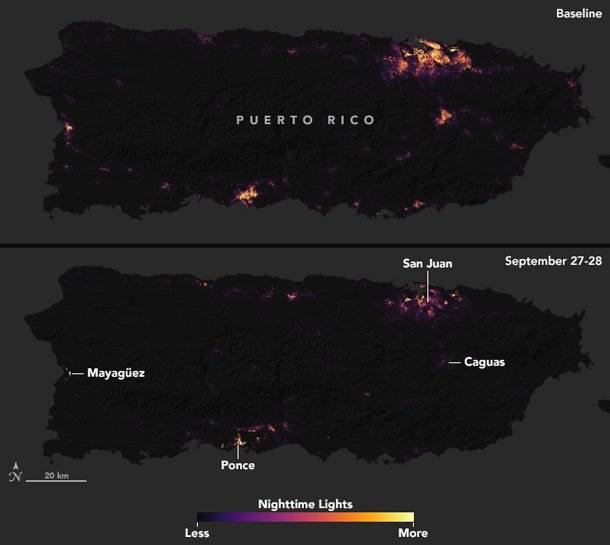
Puerto Rico has largely gone dark in the wake of the disruption to its centralized power grid brought by Hurricane Maria. (Photo: NASA Earth Observatory images by Joshua Stevens, using data courtesy of Miguel Román, NASA GSFC, and Andrew Molthan, NASA MSFC.)
CURWOOD: Bob, from what you know about energy and renewable energy, how do you think Puerto Rico ought to rebuild its system there?
ENGELMAN: Well, I think it's important to first state that the real priority in Puerto Rico is saving lives and restoring power as quickly as possible, obviously water and other basic services people need. That's the urgent need right now. Second thing is, it has a lot to do with what Puerto Ricans want. It's not something that you and I can decide from Boston or Washington DC, what exactly they should do. They've got to be involved in the process. But the third thing to say is they have an opportunity to start thinking things fresh, and Puerto Rico like the rest of the Caribbean has an enormous renewable energy resources right there on the island.
The sunshine is more than just a draw for tourists. It's actually quite strong. The power of solar irradiance to generate solar electricity is twice as strong as it is in Germany or Denmark which themselves have the bulk of solar power that's installed in the world as a whole, and it's similar for wind. The trade winds that blow across the Caribbean and that brought Christopher Columbus to the Caribbean in 1492, they blow between 10 and 30 miles per hour almost constantly, and these are very, very good wind speeds for wind turbines.
CURWOOD: Bob, you wrote a letter to The New York Times, and you asked why should these islands rely on brittle centralized electric grids and buy imported fossil fuels when electricity could flow through flexible community grids based on locally harvested wind and solar energy. What do you mean by “flexible community grids?”
ENGELMAN: Well, there is a lot more you can do with small grids than with large grids. It's easier to make them smart and responsive to their users. They frequently involve more public participation, community decisions about pricing, fuel mix. Communities might be more enthusiastic, for example, about using renewable energy than importing new fossil fuels, as is the case of almost all the energy production, or 98 percent anyway, of the energy production that's going on in Puerto Rico.
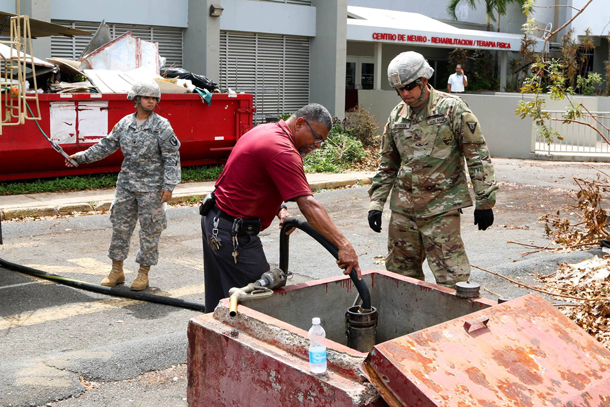
Puerto Rico National Guard Soldiers supplied the HIMA San Pablo Hospital with 4,000 gallons of diesel on Sept. 29th to power their generator and keep health services working. (Photo: Sgt. Alexis Velez / The National Guard, Flickr CC BY 2.0)
CURWOOD: And of course, to what extent is it is zero sum game between renewable and fossil fuel? I would think that a distributed energy system could encompass both.
ENGELMAN: Absolutely, the way to think about is a little bit like, is whether meat is the center of your plate or meat is a side dish when people are starting to move toward vegetarianism. You don't have to choose one or the other but you can diminish the dominance of the one that's causing the most problems.
In the case of fossil fuel, it's important frequently in a transition period to use it as a backup, for example. The sun doesn't always shine. The wind doesn't always blow. So, absolutely they can work together, but the goal would be, especially for economic reasons but also for environmental reasons, to move as close to dominance and eventually complete reliance on the renewable energy as possible.
CURWOOD: And, Bob, you're not talking about people being completely off the grid, but being on whatever local or wide area grid there is. How could storage systems help Puerto Rico make the most of its renewable resources?
ENGELMAN: Well, batteries can be integrated with grids of any size. They make renewable energy much more feasible as a really important part of your base load in any size grid, whether it's a small community grid or a centralized grid like Puerto Rico had, and in fact, Tesla - which knows a lot about this and has probably been developing batteries more intensively and rapidly than probably any other company because they need them for their cars - has in fact donated a number of what are called “Powerwall battery packs.” These are home-based sort of small refrigerator size packs that can enable homes to save the power that they get from the sun during the day so they can use it in the night time and other times, cloudy weather, etcetera.
CURWOOD: Bob, how resilient can solar and wind energy infrastructure be in a disaster such as a major hurricane that well, as we know, completely trashed Puerto Rico?
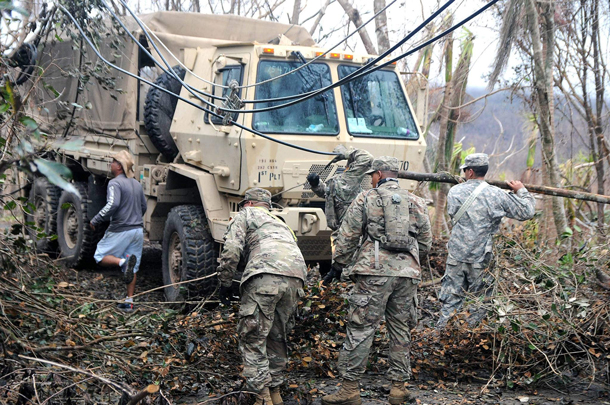
Citizen soldiers of the Puerto Rico Army National Guard, alongside residents of the municipality of Cayey, clear downed power lines and other debris left by Hurricane Maria. (Photo: Staff Sgt. Wilma Orozco Fanfan, 113th MPAD / Puerto Rico Army National Guard, Flickr CC BY 2.0)
ENGELMAN: Right, well, here’s the good news. Puerto Rico has the largest wind farm in the Caribbean, and we just got news that it survived the hurricane intact, every one of its, I think, 44 turbines is operating just as before the hurricane. That's amazing, so that's a part of its infrastructure that wasn't destroyed. That said, one of its other, much smaller wind farms did suffer some rotor damage because the rotors didn't close down the way they're supposed to in high winds. Wind turbines these days, the best of them are built to withstand about a Category three hurricane, but, as we know, Puerto Rico got hit by a Category four hurricane when Maria landed. So, there is an issue. It's not to say that it's perfectly resilient. Photovoltaic panels can blow off of roofs. So, this is not a binary situation where renewable is completely resilient and non-renewable is totally vulnerable.
But, I would say that renewable has an big advantages. You don't have to worry about having port facilities to import your fuels. It's going to be an issue for Puerto Rico whether it can import it fossil fuels it needs for a system given its port situations. There are a lot of reasons to think that, in general, renewable energy is likely to be more resilient, again, particularly if you're talking about distributed energy that’s small scale, that communities can control, ideally close to the ground, that doesn't require long distance transmission lines, etcetra. I think, on balance, resilience favors renewable energy well over fossil fuel energy.
CURWOOD: Let's talk about cost now. In some places wind and solar are cheaper than fossil fuel, certainly cheaper than coal. But one thing about renewable energy if you pretty much pay for all that energy up front. You buy the solar cells, buy the wind turbines and after that the costs are pretty cheap.
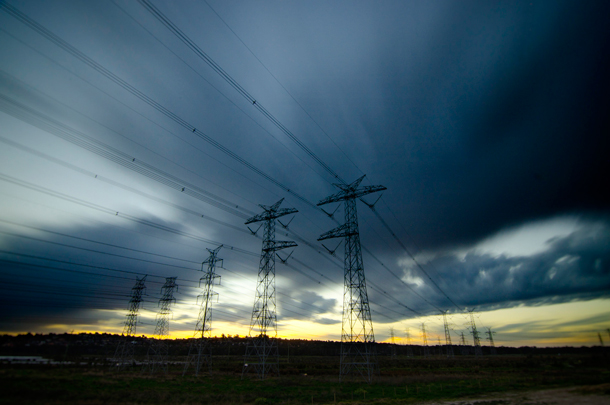
High-voltage transmission lines are a key part of a centralized grid, but they are susceptible to powerful hurricane winds. (Photo: Indigo Skies Photography, Flickr CC BY-NC-ND 2.0)
ENGELMAN: That's right.
CURWOOD: Puerto Rico has a lot of financial problems. Officially, it's what $75 billion dollars in debt, even before Maria. So, at the end of the day, how feasible do you think it's going to be for Puerto Rico to be investing in renewable energy?
ENGELMAN: I think it will be difficult for Puerto Rico itself to invest in renewable energy, which is a shame because over the long term it would be really helpful to its economy. But there is a federal act that was passed late in the Obama administration, with bipartisan support, I might add, called Promesa, which guarantees a bit of a break from creditors, the holders of Puerto Rico's bonds, and puts together an oversight board to make a plan for how Puerto Rico can handle its debt problems. And I would suggest that we gather this oversight board in San Juan and take a look at Puerto Rico's situation and see if some of its debt could be delayed, for example, and perhaps money could be diverted from what Puerto Rico has to repay, to at least assessing the potential to integrate as much sustainable and renewable energy as possible, as we repair the basic energy infrastructure of Puerto Rico.
I think it's really critical that we make a collective national effort to, I think, look at Puerto Rico as both for the benefits of its own citizens and the benefit of the country as a whole, a kind of a laboratory for how to make renewable energy work, and that's one reason I suggested, in a recent letter to The New York Times, that we consider federal/private partnerships that take on some of these upfront costs, not as a bail-out but as a way of learning from what we can do in one island with 3.4 million Americans, how it can become self-sufficient in energy and resilient in energy and resilient against the kind of super storms that are very likely to be hitting Puerto Rico in the coming decades.
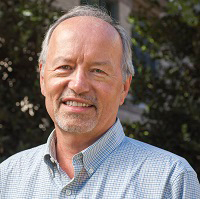
Robert Engelman is a Senior Fellow at the Worldwatch Institute and its former President. (Photo: Worldwatch Institute)
CURWOOD: Some would say that Puerto Ricans have second-class citizenship when they're on the island. They can't vote for president of the United States or the Electoral College or get voting members of Congress, and that this is a considerable obstacle perhaps to this energy revolution that you're calling for for Puerto Rico. How might one deal with that fact? How might America be able to move forward on the status of Puerto Rico, at the same time that it responds to the devastating emergency there?
ENGELMAN: I think one important point is that as Puerto Rico develops, in terms of its energy system and in terms of developing economically and in terms of how they handle the incredible emergency disaster they've had to face, they're going to prove to the mainland American people who've been watching them that they're worthy of full citizenship, and they have a right to be a state. They're more populous than a number of states we have, and it may be that, I wouldn't necessarily call it a silver lining to this incredible disaster emergency they face, but it may be that in their own resilience, in the resilience of the Puerto Rican people in dealing with this emergency and working with the rest of America, the rest of the United States, there will be more opportunity, more chance people will be more sympathetic to the fact that they deserve full citizenship and full political and electoral participation in the United States’ representative democracy.
CURWOOD: So, it's not just electricity when you say "power to the people" of Puerto Rico.
ENGELMAN: [LAUGHS] I'll let you go with that, but that's a good one, power to the people of Puerto Rico. They're certainly connected. There's no question that having a resilient dependable power supply is critical to economic development, and economic development is critical to being fully integrated into the United States.
CURWOOD: Robert Engelman is a senior fellow and former president of the environmental think tank, Worldwatch Institute. Bob, thanks so much for taking the time with me today.
ENGELMAN: Thanks for having me, Steve.
Links
Robert Engelman’s NYTimes Letter to the Editor, Sep. 28th 2017
Bloomberg: “Puerto Rico to Get Power Relief From German Microgrid Supplier”
Living on Earth wants to hear from you!
Living on Earth
62 Calef Highway, Suite 212
Lee, NH 03861
Telephone: 617-287-4121
E-mail: comments@loe.org
Newsletter [Click here]
Donate to Living on Earth!
Living on Earth is an independent media program and relies entirely on contributions from listeners and institutions supporting public service. Please donate now to preserve an independent environmental voice.
NewsletterLiving on Earth offers a weekly delivery of the show's rundown to your mailbox. Sign up for our newsletter today!
 Sailors For The Sea: Be the change you want to sea.
Sailors For The Sea: Be the change you want to sea.
 The Grantham Foundation for the Protection of the Environment: Committed to protecting and improving the health of the global environment.
The Grantham Foundation for the Protection of the Environment: Committed to protecting and improving the health of the global environment.
 Contribute to Living on Earth and receive, as our gift to you, an archival print of one of Mark Seth Lender's extraordinary wildlife photographs. Follow the link to see Mark's current collection of photographs.
Contribute to Living on Earth and receive, as our gift to you, an archival print of one of Mark Seth Lender's extraordinary wildlife photographs. Follow the link to see Mark's current collection of photographs.
 Buy a signed copy of Mark Seth Lender's book Smeagull the Seagull & support Living on Earth
Buy a signed copy of Mark Seth Lender's book Smeagull the Seagull & support Living on Earth

